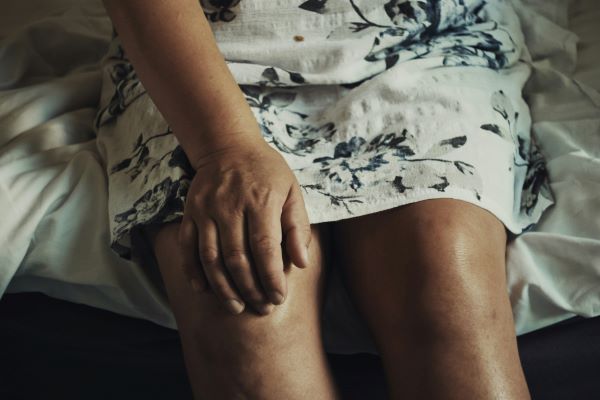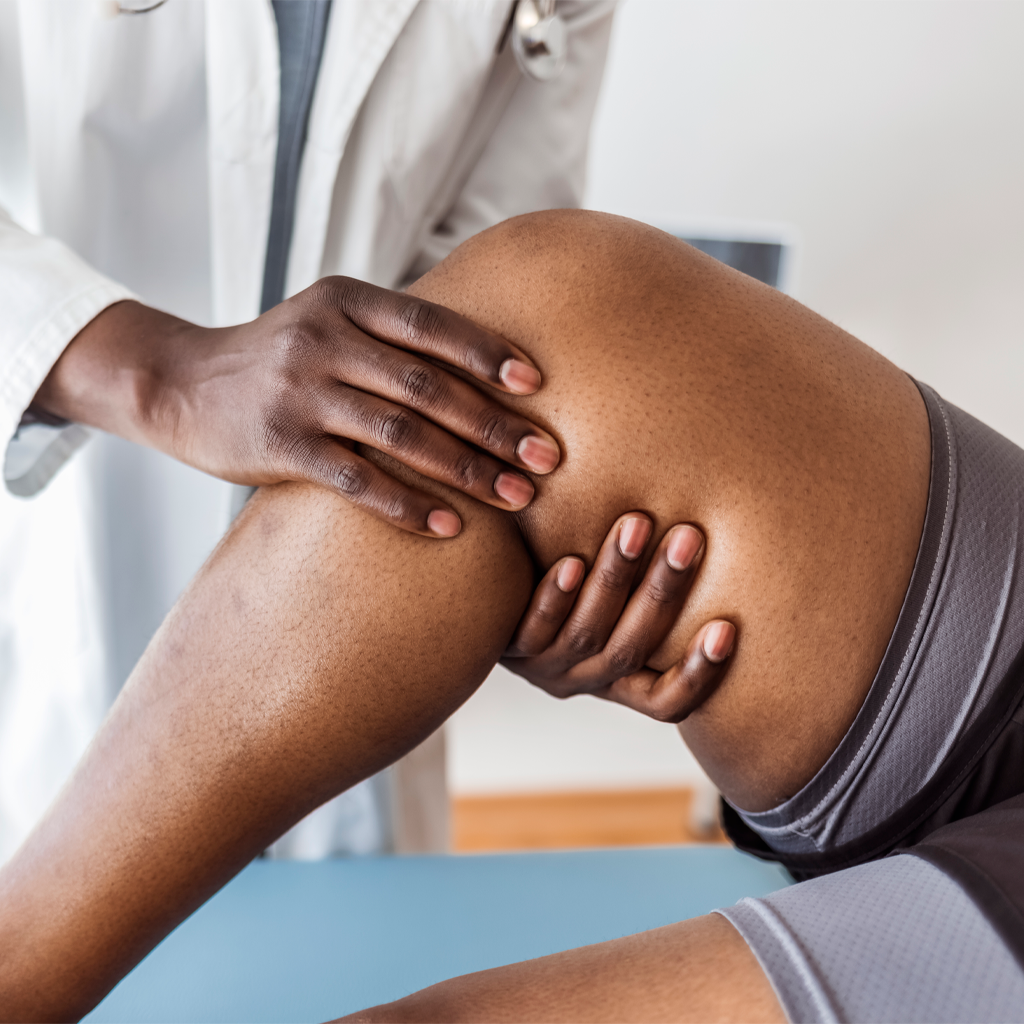Can non-surgical treatment for knee pain relieve the discomfort of osteoarthritis? Many people suffer from the discomfort of osteoarthritis of the knee. And they want relief, but they would prefer to avoid surgery. Or, their bodies can't tolerate such an invasive surgery. But how effective can the relief be if you avoid total knee replacement? Here's what you need to know.

Effectiveness of Non-Surgical Treatment for Knee Pain
In the past, non-surgical treatment options for osteoarthritis pain involved management with lifestyle changes and medication. And, while these methods were effective for those with mild to moderate arthritis pain, those with more serious conditions would need to explore surgery for relief, or choose to live with the pain, stiffness and limits on mobility.
Recently, the drug company Novartis conducted a clinical trial for an injectable medication that would help deliver knee pain relief for osteoarthritis patients. Unfortunately, they have just announced the trial’s determination because the medication was not delivering sufficient relief.
Luckily, there are still other options if you want to fight arthritis pain and avoid surgery, including minimally invasive procedures such as Genicular Artery Embolization. And, according to research presented at the Society of Interventional Radiology's annual meeting, the procedure delivers significant pain reduction for those with knee pain caused by osteoarthritis. Moreover, the first-of-its-kind study revealed that the procedure is particularly effective for adults aged 50 and older.
In revealing these results, Dr. Kaitlin Carrato of MedStar Georgetown University Hospital said, "We know this treatment has clear benefits in reducing pain and improving the ability to do everyday activities for patients. But now that we know it's particularly helpful for those over 50 years old, it may mean that those with chronic pain conditions, like arthritis, would benefit more from this treatment than patients suffering acute pain, such as an injury."
Ready to explore non-surgical treatment for knee pain? Want to relieve the discomfort of osteoarthritis without overnight hospital stays or a total knee replacement? We're ready to answer all your questions and review your candidacy for the GAE procedure. Simply click here to request an appointmentclick here to request an appointmentclick here to request an appointment.
Knee osteoarthritis can cause debilitating symptoms such as pain, stiffness, swelling and limits on your range of motion. Now, this degenerative disease is a problem for men and women, affecting close to 365 million people worldwide. Often associated with aging, recent studies reveal that—for women—menopause is causing women to be disproportionately impacted by this degenerative condition. Here’s what you need to know.

Knee Osteoarthritis in Post-Menopausal Women
In this study, researchers scoured the 2021 Global Burden of Disease study, looking for notable health trends. And here’s what they found. Between 1990 and 2021, the prevalence of osteoarthritis diagnoses among post-menopausal women increased 1.3-fold. And, while that was true of all types of osteoarthritis, diagnoses involving the knee joints were most prevalent. Now, factors such as obesity and socio-economic status also contributed to disease burden, but researchers concluded that the biggest contributing factor was menopause. As such, they suggest implementing better screening practices and risk factor reduction measures in post-menopausal women.
Knee Pain Relief After the Onset of Osteoarthritis
Women can reach menopause in their late 40s or early 50s, meaning their risk for knee osteoarthritis can increase at a relatively young age. Unfortunately, if you develop painful symptoms and wish to undergo knee replacement surgery for relief, that can put you in an awkward position—typical knee implants have a shelf life of about 20 years, at best. So, if you undergo surgery at a young age, you may need to seek a revisionary procedure by the time you hit your 70s.
Looking for an alternative that can help you delay or avoid knee replacement surgery? It’s time to explore genicular artery embolization (GAE), a minimally invasive procedure that provides non-surgical knee pain relief. A great option for younger post-menopausal women suffering from arthritis symptoms, or for anyone who’s not ready to undergo surgery, you can learn more about this treatment option by requesting a consultation requesting a consultation requesting a consultation at the Texas Knee Institute.
Knee pain due to osteoarthritis can make it difficult to enjoy an active life. In the past, many people had to treat this pain with total knee replacement surgery. But this procedure is expensive, invasive, requires a long recovery period, and doesn’t always provide the relief you need. Today, however, you can find osteoarthritis knee pain relief with non-surgical treatment for knee pain, including lifestyle changes, supplements, medications such as Ozempic or Wegovey, and genicular artery embolization (GAE). This minimally-invasive procedure effective reduces or eliminates your pain without requiring general anesthesia or overnight hospital stays. Want to learn more? Keep reading to discover the ins and outs of this alternative to knee surgery, along with other available options.
Turmeric for Knee Pain Relief
For a completely natural way to address arthritis pain, you may want to try taking a daily turmeric supplement. According to this study in the Annals of Internal Medicine, taking a daily dose of 1000mg of turmeric for 12 weeks provided participants with osteoarthritis noticeable knee pain relief. However, there was no reduction in swelling or cartilage composition. As such, this may not provide sufficient relief for many patients.
Ozempic as a Non-Surgical Treatment Option
According to research in The New England Journal of Medicine, taking once weekly doses of semagultide weight-loss drugs (prescribed under the brand-names of Ozempic and Wegovy) can help provide knee pain relief for those with osteoarthritis linked to obesity. As such, this drug could be a promising non-surgical treatment for pain in your knee. However, it’s efficacy was only proven for individuals who also needed to lose weight. Therefore, those whose knee pain is unrelated to obesity may choose to explore treatment options such as genicular artery embolization (GAE).

What is Genicular Artery Embolization for Knee Pain?
GAE is a minimally invasive knee procedure that, for many patients, offers an advantageous alternative to knee surgery. First, it’s a non-surgical procedure that carries a minimal risk for complications, making it an ideal knee pain treatment for those who prefer to avoid surgery or who aren’t able to undergo invasive procedures. Moreover, it is less expensive than surgical procedures, and typically covered by insurance. After GAE, you can expect a much faster recovery time than you’d face after a surgical procedure. Plus, by addressing one of the root causes of discomfort linked to osteoarthritis—inflammation—it can effectively reduce your discomfort and improve your quality of life, especially for those experiencing knee osteoarthritis symptoms.
GAE Procedure: Taking a Closer Look
When you undergo Genicular Artery Embolization, we inject an embolic agent, via catheter, to reduce blood flow to the genicular arteries around your knee. Afterward, inflammation is reduced, and most patients report reduced discomfort along with improved mobility and an overall better quality of life.
Recovering from GAE
Most people can resume normal activities within days of undergoing genicular artery embolization. Knee pain relief after GAE will initially start improving 4-6 weeks after the procedure, with results further improving over time. Plus, because the procedure is less invasive than surgery, post-GAE discomfort should be minimal, and most patients can manage discomfort with over-the-counter medications.
Do you need relief from the pain of osteoarthritis, but want an alternative to surgery? GAE in Texas could be the option you’ve been seeking. Simply click here click here click here to request a consultation at the Texas Knee Institute, and we’ll review your candidacy for genicular artery embolization
When you have knee pain due to arthritis, your doctor may suggest trying osteoarthritis knee exercises. While there is no cure for arthritis, regular exercise can help manage stiffness and preserve mobility. However, for more lasting relief, you may need to seek medical intervention.

What are the best osteoarthritis knee exercises?
While exercise can't cure arthritis, it can help you build strength, move with greater ease and knee relieve pain. Regular exercise can also help you maintain a healthy weight, improve your balance and even sleep better at night. Now, before starting a new exercise routine, make sure to clear your proposed activities with a doctor. Then, consider trying some or all of these osteoarthritis knee exercises:
- Daily stretching
- Weight-bearing activities with resistance bands, hand weights or weighted machines, ideally performed every other day
- Moderate, joint-friendly cardiovascular exercises such as swimming, walking or biking
- Yoga or tai chi routines that can help improve balance and posture while reducing tension
Knee Osteoarthritis Stretches
Stretching your hamstrings each day can preserve flexibility while improving your joint range of motion. It can also help with knee pain relief or prevention. To start, warm up your body by walking for about five minutes. Next, lie down flat and loop a strap or bedsheet around one of your feet. Gently use the sheet to help pull your leg straight, holding the position for at least 20 seconds. Give yourself a break and repeat on your first leg before switching to your other one. You can also support your knee health by stretching your calf muscles. Begin by holding onto a chair to keep your balance. Now, bend one leg and step back with the other, straightening it slowly and carefully behind you. Move your heel toward the floor until you feel a nice stretch in the back of the back leg. Hold the position for at least 20 seconds and then switch sides.
Adding these stretches to your daily routine, in combination with gentle exercises, can help you maintain mobility, even when you’re living with knee osteoarthritis. Just be sure to take care with movement, so you don’t cause yourself pain or worsen any joint damage.
Tips for exercising with osteoarthritis of the knee
When you are beginning a new exercise routine and dealing with the pain of osteoarthritis in your knee, start slow and listen to your body. If working out with a trainer or taking a group fitness class, make sure to inform the instructor about your arthritis. And always listen to your body: stop and rest if any exercise causes you pain.
Additionally, any osteoarthritis knee exercises should be low impact. Before exercising, apply 20 minutes of gentle heat (warm towels or a warm shower both work) to your affected joints. And, after completing a workout, ice your joints for up to 20 minutes to address any possible swelling.
Non-surgical relief for knee osteoarthritis
If you're hoping to manage your pain with osteoarthritis knee exercises, you'd probably like to avoid surgery. And, even when lifestyle measures fail to manage your arthritis-related knee pain, you can find meaningful relief with Genicular Artery Embolization (GAE) in Texas.
This minimally invasive procedure relieves pain and inflammation and helps you delay or avoid knee replacement surgery. Performed by our interventional radiologists in Houston and Dallas, GAE may also help prevent disease progression for arthritis patients. Ready to see if you're a candidate for GAE? Click here to request an appointmentClick here to request an appointmentClick here to request an appointment today!
Finding knee pain relief for osteoarthritis can be a costly endeavor. Many options, including physical therapy and injected medications, require ongoing expenses…and, often, they don’t even provide lasting relief. Want to reduce the pain of knee osteoarthritis and preserve your mobility without breaking the bank or going under the knife? It’s time to explore genicular artery embolization (GAE), a minimally invasive procedure that was recently deemed a cost-effective knee osteoarthritis treatment by the American Journal of Roentgenology (AJR).

The Cost of Resolving Knee Pain Due to Osteoarthritis
More than 80% of people with osteoarthritis experience joint pain in their knees. And, according to this 2024 study, providing patients with knee pain relief costs more than $80 billion. Of course, there are a variety of ways to treat knee osteoarthritis, and some will be more expensive (and more effective) than others. But, for the purposes of the review in AJR, study authors compared the costs and results associated with GAE, RFA [radiofrequency ablation] and CS [corticosteroid injection] over a period of four-years. And here’s what they discovered.
GAE: A Cost-Effective Knee Osteoarthritis Treatment
What do GAE, RFA and CS all have in common? They can all relieve osteoarthritis pain without surgery. As such, researchers decided to compare their relative costs, along with the relief each option could provide. And, over the four-year study period, researchers discovered that “GAE was consistently the most likely cost-effective treatment option compared to RFA and CS.” As such, the authors noted that this information would be helpful for patients seeking knee pain relief among a growing range of available treatment options.
Now, the exact cost of the GAE procedure will depend on a variety of factors, including your personal insurance plan. But here’s what we want you to know: this minimally invasive procedure can improve your quality of life, allowing you to find pain relief without surgery. And, whether you have questions about the cost of GAE or your candidacy for this procedure, we’re here to help. Simply request a consultation request a consultation request a consultation with our team at the Texas Knee Institute.
When you’re living with osteoarthritis knee pain, we know the thought of worsening discomfort is frightening. So what can you avoid worsening knee pain? And what action can you take to find lasting knee pain relief? Here’s what you need to know!

4 Things That Make Knee Pain Worse
Avoid these mistakes if you don’t want to experience worsening osteoarthritis knee pain!
1. Remaining sedentary
Many patients with knee pain try to use their knees less, hoping that doing so will allow their joints to rest and heal. Unfortunately, the less you move your knees, the weaker your joints can become, ironically worsening your discomfort. So, what should you do instead? As long as you’ve been cleared for movement by your doctor, keep getting regular exercise, choosing movements such as cycling that can lubricate your knee joints, reducing your discomfort and preserving your mobility.
2. Carrying extra weight
Every extra pound you carry puts excess pressure on your tender knee joints. That’s why this study suggests that taking Semaglutide once weekly can help individuals with obesity reduce their knee pain. And it’s why reaching and maintaining a healthy weight could help you find knee pain relief.
3. Wearing the wrong shoes
Walking around in unsupportive footwear—especially high heels—can increase pressure and pain in your knee joints. As such, wearing supportive, appropriate footwear is incredibly important for individuals who have knee osteoarthritis.
4. Ignoring your pain
In its early stages, many people can manage the pain of osteoarthritis with simple interventions such as finding relief from over-the-counter medications. However, arthritis is a progressive disease, so ignoring or masking your pain will only work for a limited time.
So, what should you do if you’re beginning to notice pain in your knees? First, speak to your healthcare provider about your symptoms, helping ensure a timely arthritis diagnosis. Then, make sure to avoid the highlighted triggers that can make knee pain worse. Finally, if your discomfort is beginning to interfere with your daily activities, and you want relief without invasive surgery, request a consultation request a consultation request a consultation at the Texas Knee Institute. Our interventional radiologists can treat knee osteoarthritis with Genicular Artery Embolization (GAE), a minimally-invasive procedure that relieves pain and inflammation while allowing you to delay or avoid knee replacement surgery.

Genicular artery embolization, or GAE is a minimally invasive, non-surgical procedure that treats knee pain caused by osteoarthritis. In fact, many patients can delay or avoid knee replacements by undergoing GAE. And, while this procedure is new to the U.S. and Europe, it's been in practice for longer in Japan. And patient data from overseas indicates that GAE provides an effective way to treat joint pain.
Osteoarthritis and Knee Pain: What's the Connection?
About 13% of women and 10% of men over the age of 60 develop osteoarthritis. This disease attacks joint linings in many places, including your knees. In turn, people develop pain, inflammation, and even limits on mobility.
Some people can manage knee osteoarthritis pain with over-the-counter anti-inflammatory medications. However, other patients only find relief with knee replacement surgery. But, there is a middle ground of patients who could benefit from a different treatment option. Sound like what you're looking for? Stick with us as we discuss genicular artery embolization. But first, let’s get a better understanding of the genicular arteries’ role in your body.
What are the Genicular Arteries?
These are a network of arteries that bring blood to your knee joint; when you have osteoarthritis, they become altered. By interrupting the flow of blood in these altered arteries, the GAE procedure can help provide knee pain relief.
Genicular Artery Embolization: What to Expect
This minimally invasive knee osteoarthritis treatment helps patients who don't find relief from conservative treatments. It also works if you prefer to avoid or aren't a good candidate for surgery. You see, during the GAE procedure, our interventional radiologists use a small catheter to inject microscopic beads into the leg arteries that supply your knee joint. This cuts the flow of blood to your synovium (also called your hypervascular joint lining.)
Afterward, you should begin to notice knee pain relief within the first four to six weeks because the procedure relieves inflammation and thickening of the synovium—the main source of osteoarthritis pain. Even better? This procedure could also prevent cartilage breakdown, helping to slow arthritic progression in your joint.
Who's a Good GAE Candidate?
Genicular artery embolization offers prolonged relief from joint pain. It can also help improve your ability to walk and navigate stairs, while reducing inflammation and slowing arthritis progression. Luckily, GAE is a minimally-invasive, outpatient procedure, meaning it comes with a shorter recovery period and allows you to avoid overnight hospital stays. As a result, most patients resume normal activities (with light restrictions) one day after GAE.
The New Alternative to Knee Replacement Surgery
The best candidates for GAE are patients who wish to avoid surgery, incisions, stitches, staples and general anesthesia. And guess what? Genicular artery embolization isn't a one-time relief option. As a result, if your knee pain returns after six months to a year, you can undergo another GAE procedure, once again delaying surgery and the progression of osteoarthritis.
Want to learn more about GAE, and see if this procedure can help you stay active while living with arthritis? You can request an appointment request an appointment request an appointment with our Texas Knee Institute's interventional radiologists. Together, we'll determine if this is your best osteoarthritis treatment option.
Cycling is a great form of exercise if you have knee osteoarthritis. It’s a lower impact workout, but still provides plenty of cardiovascular benefits, and could even help maintain or improve your joint health, while increasing your range of motion. Here’s what you need to know.

Why Biking for Osteoarthritis is a Smart Choice
Engaging in cycling with arthritic knees can loosen joints without wearing them down. Research shows that biking builds muscle strength to support your joints while reducing the joint stiffness associated with knee osteoarthritis. More recently, this study found that biking helped provide knee pain relief while reducing evidence of joint damage in people with osteoarthritis. You might even lose some weight when you bike, which could take more pressure off your joints.
Is Indoor or Outdoor Cycling Best?
Is it better to bike outdoors or to use an indoor stationary bike if you have arthritic knees? Luckily, both are great options. Biking outdoors is a great way to enjoy nature and view changing scenery, meaning you might be up for longer training sessions. At the same time, when you pass over varying outdoor terrain, you’ll naturally be challenged to adjust to different levels of resistance and incline.
Similarly, cycling indoors can offer many benefits. First, a stationary bike can be good for knees because it’s easy to control resistance levels, without worrying about rain, heat or other environmental factors. You also won’t need to worry about falling off a stationary bike, making it a great choice for people who struggle with balance issues.
Choosing the Right Equipment and Pace
If you’re cycling with osteoarthritis of the knee in the outdoors, try keeping your seat and handlebars elevated, to reduce joint pressure and relieve potential back or neck pain. When cycling indoors, you may prefer to sit on a recumbent bike, since you can lean back and keep pressure off your back and hips. However, if you have arthritis in other areas of your body, you may prefer an upright bike, since biking in the recumbent position can be tougher on hip joints.
Regardless of your bike choice, you should start off with low-intensity cycling, proven to be as effective as high-intensity cycling for improving joint function and range of motion. If you’re new to the sport, ease your body into cycling by riding slowly on flat surfaces. Limit early sessions to no more than 10 minutes, allowing your body to adjust to this form of movement before training harder or for longer periods of time.
After finishing a cycle session, stretch gently and give your body time to recover. If you experience worsening joint pain after exercising, stop cycling and talk to your doctor to avoid injury or further joint damage. And if exercise has become too painful, or you need more knee pain relief, request a consultation request a consultation request a consultation at the Texas Knee Institute. Our interventional radiologists provide genicular artery embolization (learn more about What is GAE here). So, when you come in for a visit, we can help you decided if this minimally invasive knee osteoarthritis treatment is your best option for relief.
As a relatively new treatment option for knee osteoarthritis, many people wonder about the benefits of genicular artery embolization (GAE.) Now, thanks to a study from the Charity University Hospital in Berlin, we have more evidence to support GAE’s ability to provide knee pain relief. Here’s what you need to know.

What is GAE?
GAE is a minimally-invasive procedure performed by the interventional radiologists at the Texas Knee Institute. It relieves arthritis-related knee pain by targeting the genicular arteries surrounding your knee joint with an injection of small particles designed to reduce blood flow to the area. In turn, inflammation is reduced and the destruction of cartilage is slowed down, helping relieve pain while also slowing disease progression.
What are the Benefits of Genicular Artery Embolization?
Clinically, we’ve seen that patients who undergo GAE enjoy knee pain relief with improved mobility and quality of life. And now, according to study results presented at the Radiological Society of North America, we can scientifically quantify the benefits of genicular artery embolization.
For this study, German physicians followed 403 patients between the ages of 40 and 90 who underwent GAE at Charity University Hospital in Berlin. All participants had moderate to severe osteoarthritis of the knee, and hadn’t found relief from more conservative treatment options such as medications and physical therapy. All of the participants underwent technically-successful GAE procedures. And one year later, 87% of participants reported improved quality of life, while 71% reported reduced pain. Best of all, side effects were minimal—no severe complications were reported, and just 18% of participants experienced temporary (and slight) changes in skin coloration, along with mild knee pain, immediately following the procedure.
As a result of these findings, lead study author Dr. Florian Fleckenstein concluded, “GAE can effectively reduce knee pain and improve quality of life early after the treatment, with these benefits being maintained over the long term, especially for people who haven’t had success with other treatments like physical therapy or pain medications. This could potentially offer a new lease on life for many patients who suffer from debilitating pain and mobility issues, caused by osteoarthritis.”
Moreover, Dr. Fleckenstein reported, “GAE has the potential to reduce the need for more invasive surgeries, lower health care costs and significantly improve the quality of life for countless individuals suffering from knee osteoarthritis."
Want to explore the benefits of GAE in Texas and discover whether you’re a candidate for this procedure? We’re here to help you explore your options. Simply reach out to our team to request your consultation request your consultation request your consultation with the team at the Texas Knee Institute.
Osteoarthritis and rheumatoid arthritis are both conditions that impact joint health. But the way they progress and their treatment offers diverge. This post highlights important differences between rheumatoid arthritis vs osteoarthritis.

RA and OA: What You Need to Know
Rheumatoid arthritis (RA) is an autoimmune disease; if affected, your immune system will attack your joint linings. The disease can enter remission with treatment. However, osteoarthritis (OA) is a chronic and progressive disease that develops when due to prior injury or aging you experience a breakdown of the cartilage between your joints. This results in pain and possible deformity of the affected joints and bones.
Key Differences between Osteoarthritis vs Rheumatoid Arthritis
One key rheumatoid arthritis and osteoarthritis difference is what causes joint damage in each condition. As an autoimmune disease, RA develops due to malfunction in the immune system that causes your body to attack its own joint linings. In contrast, OA joint damage is typically due to wear and tear, progressing slowly with time instead of with the periods of flares and remission that are typical for RA sufferers.
Rheumatoid Arthritis vs Osteoarthritis Symptoms
OA sufferers typically notice symptoms in joints that are widely used, meaning the onset of knee osteoarthritis may be the first sign of a problem. Symptoms typically include swelling and joint dysfunction, along with pain and stiffness, or cracking, popping and grinding sounds that manifest with joint movement.
RA sufferers often experience pain in the smaller joints of the hands and feet. Plus, with RA, you may also experience fatigue, loss of appetite, a low-grade fevers, skin lumps known as nodules and stiffness with waking.
Diagnosis and Treatment Options
Identifying your disease risk factors and seeking prompt medical attention can help you receive an accurate diagnosis. Risk factors for OA include age; a history of joint injuries; overuse of joints; obesity; and family history. RA risk factors are less clear, though weight and family history do seem to play a role. However, when it comes to osteoarthritis vs rheumatoid arthritis, being a woman, smoking or certain chemical exposures increase your RA risk, while these factors do not seem to play a significant role in OA risk.
Now, both OA and RA are incurable, and existing damage to your joints can’t be reversed. However, with medications and lifestyle modifications, you should be able to enter RA remission. Some patients with OA may find symptom relief by taking pain medications such as acetaminophen or non-steroidal anti-inflammatories. But many may also require a medical intervention such as the genicular artery embolization (GAE) procedure to get relief. But what is GAE? In short, it’s a minimally invasive procedure that provides OA knee pain relief by interrupting the flow of blood flow to the knee joint lining. While not an option for everyone, you can request a consultation request a consultation request a consultation with the Texas Knee Institute to learn more about this procedure and explore your candidacy.







